同等学力经济综合国际经济学第五章考点测试题
在职申硕同等学力经济学(国际经济学)模拟试卷5(题后含答案及解析)
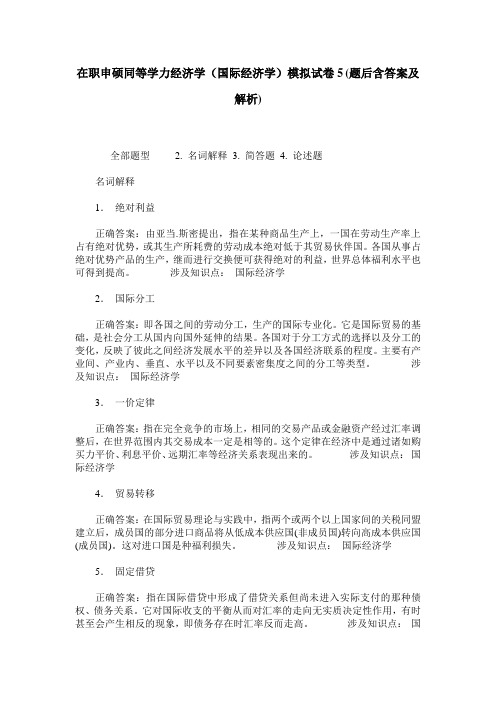
在职申硕同等学力经济学(国际经济学)模拟试卷5(题后含答案及解析)全部题型 2. 名词解释3. 简答题4. 论述题名词解释1.绝对利益正确答案:由亚当.斯密提出,指在某种商品生产上,一国在劳动生产率上占有绝对优势,或其生产所耗费的劳动成本绝对低于其贸易伙伴国。
各国从事占绝对优势产品的生产,继而进行交换便可获得绝对的利益,世界总体福利水平也可得到提高。
涉及知识点:国际经济学2.国际分工正确答案:即各国之间的劳动分工,生产的国际专业化。
它是国际贸易的基础,是社会分工从国内向国外延伸的结果。
各国对于分工方式的选择以及分工的变化,反映了彼此之间经济发展水平的差异以及各国经济联系的程度。
主要有产业间、产业内、垂直、水平以及不同要素密集度之间的分工等类型。
涉及知识点:国际经济学3.一价定律正确答案:指在完全竞争的市场上,相同的交易产品或金融资产经过汇率调整后,在世界范围内其交易成本一定是相等的。
这个定律在经济中是通过诸如购买力平价、利息平价、远期汇率等经济关系表现出来的。
涉及知识点:国际经济学4.贸易转移正确答案:在国际贸易理论与实践中,指两个或两个以上国家间的关税同盟建立后,成员国的部分进口商品将从低成本供应国(非成员国)转向高成本供应国(成员国)。
这对进口国是种福利损失。
涉及知识点:国际经济学5.固定借贷正确答案:指在国际借贷中形成了借贷关系但尚未进入实际支付的那种债权、债务关系。
它对国际收支的平衡从而对汇率的走向无实质决定性作用,有时甚至会产生相反的现象,即债务存在时汇率反而走高。
涉及知识点:国际经济学6.外汇倾销正确答案:利用本币对外贬值机会,向外倾销商品和争夺市场的行为。
这是因为本国货币贬值后,出口商品用外国货币表示价格降低,提高了该国商品在国际市场上的竞争力,有利于扩大出口;而因本国货币贬值,进口商品的价格上涨,削弱了进口商品的竞争力,限制了进口。
外汇倾销需要一定的条件,主要是本国货币对外贬值速度要快于对内贬值速度以及对方不进行报复。
同等学力经济综合国际经济学整理笔记资料
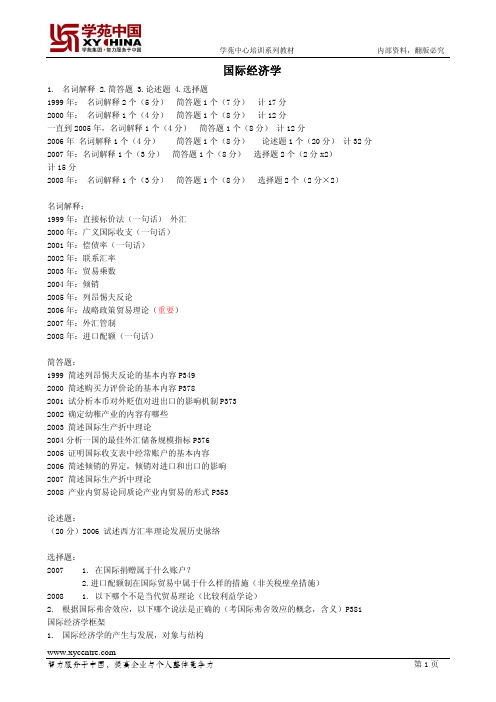
简答题: 1999 简述列昂惕夫反论的基本内容 P349 2000 简述购买力评价论的基本内容 P378 2001 试分析本币对外贬值对进出口的影响机制 P373 2002 确定幼稚产业的内容有哪些 2003 简述国际生产折中理论 2004 分析一国的最佳外汇储备规模指标 P376 2005 证明国际收支表中经常账户的基本内容 2006 简述倾销的界定,倾销对进口和出口的影响 2007 简述国际生产折中理论 2008 产业内贸易论同质论产业内贸易的形式 P353
3. 进口配额 P360(去年考过了) 5. 倾销 P361-362 (说过简答) (倾销及三要件,倾销的危害性) 6. 基于利润最大化的倾销 P364-365 简答 7. 反倾销税 P366 简答 8. 补贴与反补贴 P367 简答 9. 幼稚产业保护 (2002 年考过)(幼稚产业保护及三个判别标准 P368) 10. 关税有效保护率计划 P370
图中,实际交换比率将处于由两国国内交换比率界定的两国交换区内,然而具体的交换比率即 dY/dX 的斜 率,仅从供给方面是无法说明的,需由相互需求方程式才能说明。
智力服务于中国,提高企业与个人整体竞争力
第2页
学苑中心培训系列教材
内部资料,翻版必究
在由比较利益决定的两国交换比率的上、下限内,实际而且是唯一的均衡贸易条件,是由两国对于交易对
的当代理论:(1)产业内贸易理论 (2)政策贸易理论:1.战略政策 2. 贸易扭曲
第一章 国际经济学的产生与发展
1. 封闭经济与开放经济 2. 国际经济学:以经济学的一般理论为基础,研究国际经济活动和国际经济关系,是一般经济理论在国际
经济活动范围中的应用与延伸,是经济学体系的有机组成部分。主要研究对象有国际贸易理论与政策、 国际收支理论、汇率理论、要素的国际流动、国际投资理论、开放的宏观经济均衡等。 P325
同等学力国际经济学练习题(二)含标准答案
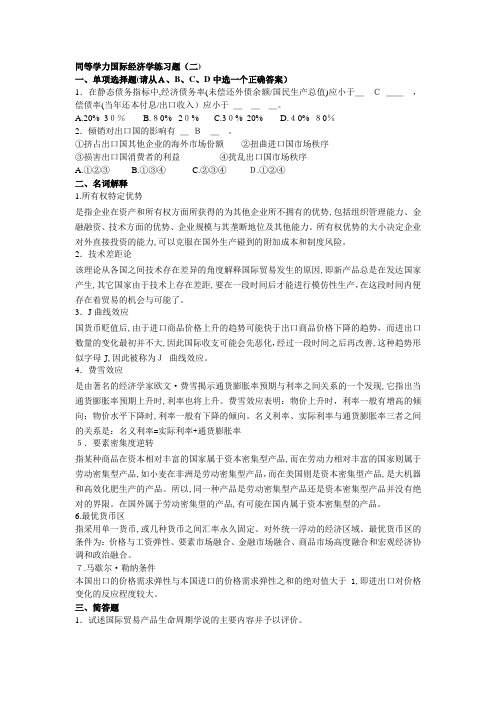
同等学力国际经济学练习题(二)一、单项选择题(请从A、B、C、D中选一个正确答案)1.在静态债务指标中,经济债务率(未偿还外债余额/国民生产总值)应小于___C_____,偿债率(当年还本付息/出口收入)应小于________。
A.20% 30%B.80% 20%C.30% 20%D.40% 80%2.倾销对出口国的影响有___B_____。
①挤占出口国其他企业的海外市场份额②扭曲进口国市场秩序③损害出口国消费者的利益④扰乱出口国市场秩序A.①②③B.①③④C.②③④D.①②④二、名词解释1.所有权特定优势是指企业在资产和所有权方面所获得的为其他企业所不拥有的优势,包括组织管理能力、金融融资、技术方面的优势、企业规模与其垄断地位及其他能力。
所有权优势的大小决定企业对外直接投资的能力,可以克服在国外生产碰到的附加成本和制度风险。
2.技术差距论该理论从各国之间技术存在差异的角度解释国际贸易发生的原因,即新产品总是在发达国家产生,其它国家由于技术上存在差距,要在一段时间后才能进行模仿性生产,在这段时间内便存在着贸易的机会与可能了。
3.J曲线效应国货币贬值后,由于进口商品价格上升的趋势可能快于出口商品价格下降的趋势,而进出口数量的变化最初并不大,因此国际收支可能会先恶化,经过一段时间之后再改善,这种趋势形似字母J,因此被称为J曲线效应。
4.费雪效应是由著名的经济学家欧文·费雪揭示通货膨胀率预期与利率之间关系的一个发现,它指出当通货膨胀率预期上升时,利率也将上升。
费雪效应表明:物价上升时,利率一般有增高的倾向;物价水平下降时,利率一般有下降的倾向。
名义利率、实际利率与通货膨胀率三者之间的关系是:名义利率=实际利率+通货膨胀率5.要素密集度逆转指某种商品在资本相对丰富的国家属于资本密集型产品,而在劳动力相对丰富的国家则属于劳动密集型产品,如小麦在非洲是劳动密集型产品,而在美国则是资本密集型产品,是大机器和高效化肥生产的产品。
国际经济学英文版上册(第八版)章节练习第五章

国际经济学英⽂版上册(第⼋版)章节练习第五章International Economics, 8e (Krugman)Chapter 5 The Standard Trade Model1) The concept "terms of trade" meansA) the amount of exports sold by a country.B) the price conditions bargained for in international markets.C) the price of a country's exports divided by the price of its imports.D) the quantities of imports received in free trade.E) None of the above.Answer: C2) A country cannot produce a mix of products with a higher value than whereA) the isovalue line intersects the production possibility frontier.B) the isovalue line is tangent to the production possibility frontier.C) the isovalue line is above the production possibility frontier.D) the isovalue line is below the production possibility frontier.E) the isovalue line is tangent with the indifference curve.Answer: B3) Tastes of individuals are represented byA) the production possibility frontier.B) the isovalue line.C) the indifference curve.D) the production function.E) None of the above.Answer: C4) If P C/P F were to increase in the international marketplace, thenA) all countries would be better off.B) the terms of trade of cloth exporters improve.C) the terms of trade of food exporters improve.D) the terms of trade of all countries improve.E) None of the above.Answer: B5) If P C/P F were to increase,A) the cloth exporter would increase the quantity of cloth exports.B) the cloth exporter would increase the quantity of cloth produced.C) the food exporter would increase the quantity of food exports.D) Both A and C.E) None of the above.Answer: B6) If a small country were to levy a tariff on its imports then this wouldA) have no effect on that country's economic welfare.B) increase the country's economic welfare.C) decrease the country's economic welfare.D) change the terms of trade.E) None of the above.Answer: C7) Suppose now that Home experiences growth strongly biased toward its export, cloth,A) this will tend to worsen Home's terms of trade.B) this will tend to improve Home's terms of trade.C) this will tend to worsen Foreign's terms of trade.D) this will have no effect on Foreign's terms of trade.E) None of the above.Answer: A8) Suppose that Home is a "small country," and it experiences growth strongly biased toward its export, clothA) this will tend to worsen Home's terms of tradeB) this will tend to improve Home's terms of tradeC) this will tend to worsen Foreign's terms of tradeD) this will have no effect on Foreign's terms of tradeE) None of the aboveAnswer: D9) When the production possibility frontier shifts out relatively more in one direction, we haveA) biased growth.B) unbiased growth.C) immiserizing growth.D) balanced growth.E) imbalanced growth.Answer: D10) Export-biased growth in Country H willA) improve the terms of trade of Country H.B) trigger anti-bias regulations of the WTO.C) worsen the terms of trade of Country F (the trade partner).D) improve the terms of trade of Country F.E) decrease economic welfare in Country H.Answer: D11) If the poor USAID recipient countries have a higher marginal propensity to consume each and every productthan does the United States, then such aid willA) worsen the U.S. terms of trade.B) improve the U.S. terms of trade.C) leave the world terms of trade unaffected.D) worsen the terms of trade of both donor and recipient countries.E) None of the above.Answer: B12) If, beginning from a free trade equilibrium, the (net barter) terms of trade improve for a country, then it willA) increase production of its import competing good.B) increase consumption of its export good.C) increase the quantity of its imports.D) experience an export-biased shift in its production possibility frontier.E) None of the above.Answer: C13) After WWI, Germany was forced to make large reparations-transfers of real income- to France. If themarginal propensity to consume was equal in both countries, and if France's demand was biased toward food (relative to Germany's demand pattern) then we would expect to findA) the world's relative price for food remains unchanged.B) the world's relative price for food increase.C) the world's relative price for food decrease.D) the world relative price for both food and non-food rise.E) None of the above.Answer: B14) During the 19th Century, economic growth of the major trading countries was biased toward manufacturesand away from food. The less developed countries of that time were net exporters of food. From thisinformation, we would expect to have observedA) falling terms of trade for the less developed countries.B) improving (rising) terms of trade for the less developed countries.C) no change at all in the terms of trade of the less developed countries.D) a decrease in the relative price of food.E) None of the above.Answer: B15) Immiserizing growth could occur toA) a poor country experiencing export-biased economic growth.B) a poor country experiencing import-biased economic growth.C) a poor country experiencing growth in its non-traded sector.D) a poor country experiencing capital-intensive biased growth.E) None of the above.Answer: A16) A large country experiencing import-biased economic growth will tend to experienceA) positive terms of trade.B) deteriorating terms of trade.C) improving terms of trade.D) immiserizing terms of trade.E) None of the above.Answer: C17) If a there are no international loans or capital flows, then if a country's terms of trade improve, we wouldfind thatA) the value of its exports exceeds the value of its imports.B) the value of its exports becomes less than that of its imports.C) the value of its exports exactly equals that of its imports.D) the quantity of its exports equals that of its imports.E) None of the above.Answer: C18) If the U.S. Agency for International Development transfers funds to poor countries in Sub-Saharan Africa,the conventional assumption, following Keynes' analysis would presume that this would tend toA) worsen the U.S. terms of trade.B) improve the U.S. terms of trade.C) worsen the terms of trade of the African aid recipients.D) improve the terms of trade of the African aid recipients.E) None of the above.Answer: A19) If a country's growth is biased in favor of its import, this should unequivocally improve its terms of tradeand its economic welfare. Discuss.Answer: Suppose Japan experiences economic growth biased in favor of its import substitutes. For example, assume that Japan imports components and exports final goods, but that it experiences a major growthin its components manufacture sector. Since Japan is internationally a large country in these markets,this would tend to hurt its component supplier's terms of trade (and help Japan's). However, such abias in economic growth may tend to lessen the volume of international trade. At an extreme, Japanmay become an exporter of components and an importer of final goods. If the result is a lessening ofspecialization and of the volume of trade, then this effect will lower Japan's welfare associated withgains from trade. If an actual change in the pattern of comparative advantage occurs (a possibility) thismay cause dynamic dislocations whose harm overpowers static gains for a relatively long period oftime.20) At the conclusion of World War I, Germany, as a punishment, was obliged to make a large transfer to Francein the form of reparations. Is it possible that the actual reparations may have improved Germany's economic welfare? Answer: Such a result is not likely. However, theoretically, if France's income elasticity of demand for Germany's exports was higher than Germany's income elasticity of demand for its own exportable,then the real income transfer associated with these reparations may have improved Germany's termsof trade, and improved its balance of payments, thus helping Germany in manner unanticipated in theTreaty of Verssaille. Explain.21) If the U.S. (a large country) imposes a tariff on its imported good, this will tend toA) have no effect on terms of trade.B) improve the terms of trade of all countries.C) improve the terms of trade of the United States.D) cause a deterioration of U.S. terms of trade.E) raise the world price of the good imported by the United States.Answer: C22) If Slovenia is a small country in world trade terms, then if it imposes a large series of tariffs on many of itsimports, this wouldA) have no effect on its terms of trade.B) improve its terms of trade.C) deteriorate its terms of trade.D) decrease its marginal propensity to consume.E) None of the above.Answer: A23) If Slovenia were a large country in world trade, then if it instituted a large set of subsidies for its exports, thismustA) have no effect on its terms of trade.B) improve its terms of trade.C) deteriorate its terms of trade.D) decrease its marginal propensity to consume.E) None of the above.Answer: C24) If Slovenia were a large country in world trade, then if it instituted a large set of subsidies for its exports, thismustA) cause retaliation on the part of its trade partners.B) harm Slovenia's real income.C) improve Slovenia's real income.D) improve the real income of its trade partners.E) None of the above.Answer: D25) An export subsidy has the opposite effect on terms of trade to the effect of an import tariff. Domestically atariff will raise the price of the import good, deteriorating the domestic terms of trade. A production subsidy for the export product will lower the local price of the export good, lowering the domestic terms of trade for the country. Hence the export subsidy and the import tariff have the same effect. This analysis seems tocontradict the first sentence in this paragraph. Discuss this paradox.Answer: While this (Lerner) equivalence may well occur domestically, internationally the tariff will improve a country's terms of trade. An export subsidy on the other hand will in fact lower the international priceof the (now readily available) export good, hence hurting a country's terms of trade.26) Suppose, as a result of various dynamic factors associated with exposure to international competition,Albania's economy grew, and is now represented by the rightmost production possibility frontier in the figure above. If its point of production with trade was point c, would you consider this growth to beexport-biased or import biased? If Albania were a large country with respect to the world trade of A and B, how would this growth affect Albania's terms of trade? Its real income?Answer: If point c is the production point with trade, then Albania has a comparative advantage in good B.Therefore, from the shape of the new production possibility frontier (as compared to the original one),this is clearly an export-biased growth. This ceteris paribus would tend to worsen Albania's terms oftrade. The terms of trade effect would, again ceteris paribus, worsen its real income. However, thegrowth itself acts in the opposite direction.27) Suppose, as a result of various dynamic factors associated with exposure to international competition,Albania's economy grew, and is now represented by the rightmost production possibility frontier in the figure above. If its point of production with trade was point b, would you consider this growth to beexport-biased or import biased? If Albania were a large country with respect to the world trade of A and B, how would this growth affect Albania's terms of trade? Its real income? What if Albania were a small country?Answer: If the production with trade point was point b, then the observed growth is a case of import-biased growth, and would improve Albania's terms of trade. If Albania were a small country, the world'sterms of trade would not change at all. In such a case, economic growth (with no induced change inincome distributions) would always increase its real income.。
2012年同等学力人员申请硕士学位经济学学科综合水平全国统一考试大纲及指南—国际经济学复习题、课后题

2012年同等学力人员申请硕士学位经济学学科综合水平全国统一考试大纲及指南—国际经济学复习题、课后题答案国际经济学(2012)一、名词解释1、国际经济学是指以经济学的一般理论为基础,研究国际经济活动和关系,是一般经济理论在国际经济活动范围中的应用与延伸,是经济学体系的有机组成部分。
2、绝对利益由英国经济学家亚当•斯密提出的,是指在某种商品的生产上,一个国家所耗费的劳动成本绝对低于自己的贸易伙伴国,在劳动生产率上占绝对优势。
各国从事自己占据绝对优势的产品的生产,进而交换,便可以通过贸易获益,世界的总体福利水平也可以得到提高。
3、比较利益由英国经济学家托伦斯提出、李嘉图发展的国际贸易理论,是指即使一个国家生产每种产品都具有最高生产率,处于绝对优势,而另一个国家生产每种产品都具有最低生产率,处于绝对劣势,但只要它们的劳动生产率差距在不同产品上存在区别,遵循“两利相权取其重,两弊相衡取其轻”的原则,它们便能从相互之间的国际分工和彼此贸易中获得利益。
4、国际分工是指各国之间的劳动分工和生产的国际专业化,它是经济发展的必然,是社会分工从一国国内向国外延伸的结果。
5、贸易乘数(2003)是乘数理论在对外贸易研究中用来分析对外贸易与国民收入和就业之间相互影响、相互制约的关系,描述经济内部出口促进经济增长的动态过程。
6、一价定律是指在完全竞争的市场上,相同的交易产品或金融资产经过汇率调整后,在世界范围内其交易成本一定是相等的。
7、贸易创造和贸易转移(2009)贸易创造是指产品从生产成本较高的国内生产转向成本较低的关税同盟中贸易对象国生产,本国从贸易对象国进口的一种过程和现象。
贸易转移是指产品由过去从较低生产成本国进口转向从较高成本国进口的过程和现象。
8、流动借贷是指国际借贷中形成了借贷关系并进入了实际支付的债权、债务关系,它对国际收支和汇率的走向具有决定性的作用。
9、固定借贷是指国际借贷中形成了借贷关系但尚未进入实际支付的债权、债务关系,它对国际收支和汇率的走向没有决定性作用。
2021年同等学力经济综合考试真题及答案解析
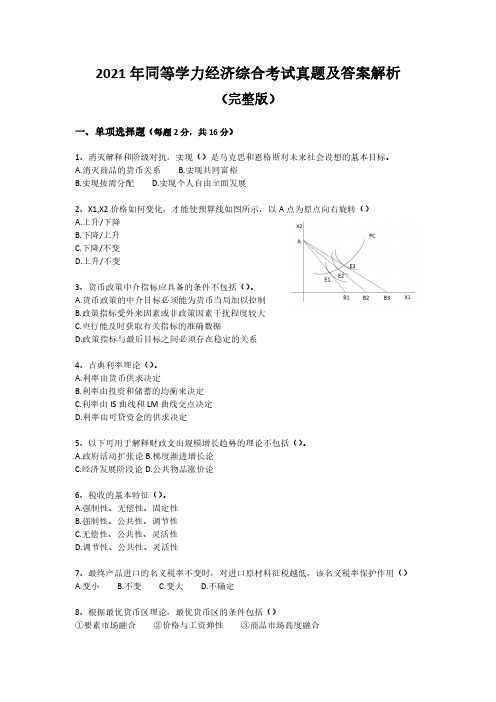
2021年同等学力经济综合考试真题及答案解析(完整版)一、单项选择题(每题2分,共16分)1、消灭解释和阶级对抗,实现()是马克思和恩格斯对未来社会设想的基本目标。
A.消灭商品的货币关系B.实现共同富裕B.实现按需分配 D.实现个人自由全面发展2、X1,X2价格如何变化,才能使预算线如图所示,以A点为原点向右旋转()A.上升/下降B.下降/上升C.下降/不变D.上升/不变3、货币政策中介指标应具备的条件不包括()。
A.货币政策的中介目标必须能为货币当局加以控制B.政策指标受外来因素或非政策因素干扰程度较大C.央行能及时获取有关指标的准确数据D.政策指标与最后目标之间必须存在稳定的关系4、古典利率理论()。
A.利率由货币供求决定B.利率由投资和储蓄的均衡来决定C.利率由IS曲线和LM曲线交点决定D.利率由可贷资金的供求决定5、以下可用于解释财政支出规模增长趋势的理论不包括()。
A.政府活动扩张论B.梯度渐进增长论C.经济发展阶段论D.公共物品涨价论6、税收的基本特征()。
A.强制性、无偿性、固定性B.强制性、公共性、调节性C.无偿性、公共性、灵活性D.调节性、公共性、灵活性7、最终产品进口的名义税率不变时,对进口原材料征税越低,该名义税率保护作用()A.变小B.不变C.变大D.不确定8、根据最优货币区理论,最优货币区的条件包括()①要素市场融合②价格与工资弹性③商品市场高度融合④国际收支顺差⑤宏观经济协调和政治融合⑥金融市场融合A.①②④⑤⑥B.①③④⑤⑥C.①②③④⑥D.①②③⑤⑥二、名词解释(每小题3分,共12分)1、边际产量2、政府采购制度3、总供给曲线4、汇兑心理学说三、简答题(每小题8分,共32分)1、什么是名义利率?什么是实际利率?请写出这两个概念的关系式。
2、简要分析风险资本的投资过程。
3、简述政府财政投资的特点。
4、国际生产折中理论四、论述与计算题(每小题20分,共40分)1、简述政府干预经济的必要性,及如何界定政府的适度干预?2、什么叫货币市场的均衡条件?已知消费函数C=100+0.8y,投资函数为I=200-6r。
同等学力经济学真题及答案解析
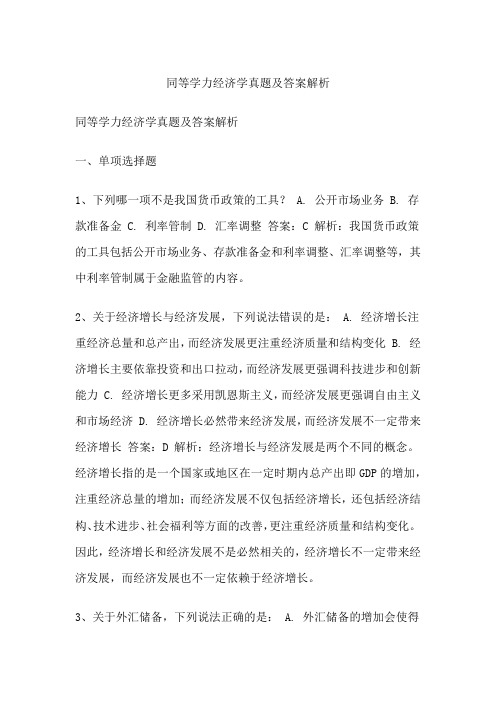
同等学力经济学真题及答案解析同等学力经济学真题及答案解析一、单项选择题1、下列哪一项不是我国货币政策的工具? A. 公开市场业务 B. 存款准备金 C. 利率管制 D. 汇率调整 答案:C 解析:我国货币政策的工具包括公开市场业务、存款准备金和利率调整、汇率调整等,其中利率管制属于金融监管的内容。
2、关于经济增长与经济发展,下列说法错误的是: A. 经济增长注重经济总量和总产出,而经济发展更注重经济质量和结构变化 B. 经济增长主要依靠投资和出口拉动,而经济发展更强调科技进步和创新能力 C. 经济增长更多采用凯恩斯主义,而经济发展更强调自由主义和市场经济 D. 经济增长必然带来经济发展,而经济发展不一定带来经济增长 答案:D 解析:经济增长与经济发展是两个不同的概念。
经济增长指的是一个国家或地区在一定时期内总产出即GDP的增加,注重经济总量的增加;而经济发展不仅包括经济增长,还包括经济结构、技术进步、社会福利等方面的改善,更注重经济质量和结构变化。
因此,经济增长和经济发展不是必然相关的,经济增长不一定带来经济发展,而经济发展也不一定依赖于经济增长。
3、关于外汇储备,下列说法正确的是: A. 外汇储备的增加会使得国内通货膨胀压力增大 B. 外汇储备主要用于国际贸易结算和国际金融市场的投资 C. 外汇储备的多少与国际贸易和国际金融市场的波动密切相关 D. 外汇储备的多少取决于国内居民国际间的资产净值 答案:C 解析:外汇储备是指为了应付国际支付的需要,各国的中央银行及其他政府机构所集中掌握并可以随时兑换成外国货币的外汇资产。
外汇储备主要用于清偿国际收支逆差以及干预外汇市场以维持该国货币的汇率。
外汇储备的多少与国际贸易和国际金融市场的波动密切相关。
二、多项选择题1、下列哪些因素会影响到国债的发行? A. 国债的利率 B. 国民的信心和预期 C. 财政政策 D. 货币政策 答案:ABCD 解析:影响国债发行的因素包括国债的利率、国民的信心和预期、财政政策以及货币政策等。
历年真题经济学汇总(同等学力)

历年同等学力人员申请硕士学位学科综合水平全一、名词解释〔每题4分, 共20分〕1.理性预期〔1999西经〕P261①2.市场失灵〔1999西经〕P197②3.汇率的直接标价法与间接标价法〔1999〕4.外汇〔1999〕5.预算体制〔1999〕6.外在性〔2000西经〕P199③7.流动性偏好陷阱〔2000西经〕P221④8.税收支出〔2000〕9.政府采购制度〔2000〕10.广义的国际收支〔2000〕11.帕累托最优状态(2001西P193.⑤12.根底货币〔2001货〕13.单一税制与复合税制〔2001财〕14.国家预算〔2001财〕15.偿债率〔2001国〕16.资本的边际效率(2002西P217) ⑥17.税收转嫁〔2002财〕18.财政赤字〔2002财〕19.资产证券化〔2002货〕20.联系汇率〔2002国〕21.总供给曲线〔2003西〕⑦22.货币政策时滞〔2003货〕23.财政政策〔2003财〕24.税收中性〔2003财〕25.贸易乘数〔2003国〕26.消费者均衡〔2004西〕P141⑧27.本钱推动的通货膨胀〔2004西〕P250⑨28.分类所得税〔2004财〕P439第1 页29.寻租行为〔2004财〕P40630.倾销〔2004国〕P32431. 资本边际效率〔2005西经考过〕⑩32. 替代效应〔2005西经〕P145⑾33. 列昂惕夫反论〔2005国经考过〕34. 赤字依存度与赤字比率〔2005财政〕35. 税收转嫁〔2005财政考过〕36. 产权制度〔2006〕37.公共产品〔2006西经〕P201⑿38. 战略贸易政策〔2006〕39. 总需求曲线〔2006西经〕P234⒀40. 收入指数化〔2006西经〕P254⒁41.产权〔2007〕〔2007西经179页〕⒂43.外汇管制〔2007〕44.综合制所得税〔2007〕45.进口配额〔2021〕46.税收中性〔2021〕47.公司治理构造〔2021〕48.理性预期假设〔2021西经〕⒃99年考过49. 价内税及价外税(2021财政)50. 所有权(2021)51. 贸易创造及贸易转移(2021)52. 投资乘数(2021西经)53. 自然失业率(2021)54. 科斯定理(2021)55. 公共定价法(2021财政)56. 里昂惕夫反论(2021)57.等产量线(2021西经)58.货币工资刚性〔2021〕59.所有权特定优势〔2021〕60.购置性支出与转移性支出〔2021财政〕第2 页二、简答题〔每题8分, 共40分〕1.简述马克思主义经典作家对未来社会根本经济特征的论述〔1999〕2.简述帕累托最优及帕累托最优条件〔1999〕3.如果要使一国的年产出增长率G从5%提高到7%,在资本产出比率V等..的前.下, 根据哈罗德-多马模型, 储蓄率应当有何变化?〔1999〕4.简述列昂惕夫反论的根本内容〔1999〕5.经济开展水平与生产技术水平对财政收入规模的制约〔1999〕6. 简述经济政策的具体目标〔2000〕7.某垄断厂商面临的需求函数是Q=60-5P〔2000〕(1) 求厂商的边际收益函数(2) 厂商收益最大时产量与价格(3) 假设厂商边际本钱为2, 求厂商利润最大化的产量及价格8.使用收入及支出法进展国民收入核算时应注意那些问题〔2000〕9.简述政府干预市场的主要手段〔2000〕10.简述购置力平价论的根本内容〔2000〕11.中国的过渡经济有哪些根本特征〔2001社〕12.简述说明西方经济学家关于金融创新的理论〔2001货〕13.如何对待微观主体预期对货币政策效应的抵消作用〔2001货〕14.试分析本币对外贬值对进出口的影响机制〔2001国〕15.简述社会公共需要的根本特征〔2001财〕16. 法人资产制度的根本特征〔2002社〕17.衍生金融产品的种类〔2002货〕18.我国货币共给的内生性〔2002货〕19.我国积极财政政策的目标〔2002财〕20.什么是幼稚产业〔H-B-K标准〕〔2002国〕21. 中国过渡经济有什么特征?〔2003社〕第3 页22. 货币政策中介目标及条件?〔2003货〕23.IS-LM模型中均衡利率是如何决定的?〔2003货〕24.简述国债的功能〔2003财〕25.简述国际生产折衷理论的内容〔2003国〕26.简述制度创新推动经济增长的机理〔2004社〕P6827.简述购置力平价理论的主要奉献〔2004货〕P57628.画图说明古典利率理论与流动偏好利率理论的根本观点〔2004货〕P496-49929.试分析一国外汇储藏的最正确规模〔2004国〕P33830.我国财政投资决策标准是什么〔2004财〕P417-41931. 为什么采用通货膨胀促进经济增长要付出沉重的代价?〔2005社大纲没有〕32. 养老保险的三种筹资模式〔2005财政〕。
同等学力申硕考试经济学综合1999-2015年真题汇编-国际经济学(优选.)

(十三)进口配额制在国际贸易政策中属于 B 。(2007) A.关税堡垒措施 B.非关税堡垒措施 C.自由贸易措施
D.与贸易政策无关的措施
名词解释
列昂惕夫反论(2005)里昂惕夫反论(2010)列昂惕夫利用投入-产出模型对美国 20 世纪 40 年代和 50 年代 的对外贸易进行了分析,发现美国参与国际分工是建立在劳动密集型专业分工之上的(即出口产品中的资本-劳 动比率低于进口替代产品),而不是建立在资本密集型专业分工基础之上的,即美国是通过对外贸易安排剩余劳 动力和节约资本的。这一结论与主流的 H-O 模型相悖。
(十一)根据最优货币区理论,最优货币区的条件为
①要素市场融合
④国际收支顺差
②价格与工资弹性 ⑤宏观经济协调和政治融合
③商品市场高度融合 ⑥金融市场融合
A.①②④⑥ B.①②③④⑥ C.①②③⑤⑥
C 。(2010、2015) D.①③④⑥
-1-
(十二)根据欧盟《马斯特里赫特条约》,进入欧元区国家的财政的标准是 A 。(2012) A.财政赤字占当年 GDP 的比重不超过 3%,政府债务占 GDP 的比重不超过 60% B.财政赤字占当年 GDP 的比重不超过 3%,政府债务占 GDP 的比重不超过 50% C.财政赤字占当年 GDP 的比重不超过 3%,外贸债务占 GDP 的比重不超过 10% D.财政赤字占当年 GDP 的比重不超过 5%,政府债务占 GDP 的比重不超过 60%
战略政策贸易理论(2006)该理论是各国在国际贸易中实行贸易干涉与干预的基础,一国可以通过各种政策 的干预(如税收、补贴、经济合作等),在对本国至关重要的生产领域中创造出比较优势,而这些生产领域具有 很强的各种前后向的联系,不仅可以带动经济发展,而且具有广泛的外部经济效益。该理论常常与产业政策之间 存在着密切联系,是在不完全竞争市场中,通过贸易获取利益,促进经济的增长与发展。
国际经济学作业答案-第五章
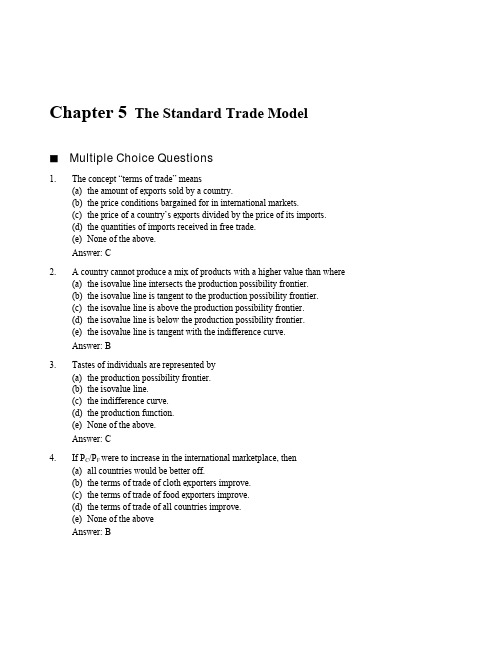
Chapter 5 The Standard Trade ModelMultiple Choice Questions1. The concept “terms of trade” means(a) the amount of exports sold by a country.(b) the price conditions bargained for in international markets.(c) the price of a country’s exports divided by the price of its imports.(d) the quantities of imports received in free trade.(e) None of the above.Answer: C2. A country cannot produce a mix of products with a higher value than where(a) the isovalue line intersects the production possibility frontier.(b) the isovalue line is tangent to the production possibility frontier.(c) the isovalue line is above the production possibility frontier.(d) the isovalue line is below the production possibility frontier.(e) the isovalue line is tangent with the indifference curve.Answer: B3. Tastes of individuals are represented by(a) the production possibility frontier.(b) the isovalue line.(c) the indifference curve.(d) the production function.(e) None of the above.Answer: C4. If P C/P F were to increase in the international marketplace, then(a) all countries would be better off.(b) the terms of trade of cloth exporters improve.(c) the terms of trade of food exporters improve.(d) the terms of trade of all countries improve.(e) None of the aboveAnswer: B5. If P C/P F were to increase,(a) the cloth exporter would increase the quantity of cloth exports.(b) the cloth exporter would increase the quantity of cloth produced.(c) the food exporter would increase the quantity of food exports.(d) Both (a) and (c).(e) None of the above.Answer: B6. If P C/P F were to increase,(a) world relative quantity of cloth supplied and demanded would increase.(b) world relative quantity of cloth supplied and demanded would decrease.(c) world relative quantity of cloth supplied would increases.(d) world relative quantity of cloth demanded would decrease.(e) None of the above.Answer: C7. When the production possibility frontier shifts out relatively more in one direction, we have(a) biased growth.(b) unbiased growth.(c) immiserizing growth.(d) balanced growth.(e) imbalanced growth.Answer: A8. Export-biased growth in Country H will(a) improve the terms of trade of Country H.(b) trigger anti-bias regulations of the WTO.(c) worsen the terms of trade of Country F (the trade partner).(d) improve the terms of trade of Country F.(e) decrease economic welfare in Country H.Answer: D9. Immiserizing growth is(a) likely to occur if the exporting country is poor.(b) likely to occur if the exporting country is rich.(c) likely to occur when terms of trade change.(d) likely to occur if relative supplies are elastic.(e) None of the above.Answer: Eword格式-可编辑-感谢下载支持10. If the U.S. Agency for International Development transfers funds to poor countries in Sub-SaharanAfrica, this must(a) worsen the U.S. terms of trade.(b) improve the U.S. terms of trade.(c) worsen the terms of trade of the African aid recipients.(d) improve the terms of trade of the African aid recipients.(e) None of the above.Answer: E11. If the poor USAID recipient countries have a higher marginal propensity to consume each and everyproduct than does the United States, then such aid will(a) worsen the U.S. terms of trade.(b) improve the U.S. terms of trade.(c) leave the world terms of trade unaffected.(d) worsen the terms of trade of both donor and recipient countries.(e) None of the above.Answer: B12. If the U.S. has a higher marginal propensity to consume (MPC) imports as compared to both its MPC forexportables and nontradables, then such aid will(a) worsen the U.S. terms of trade.(b) improve the U.S. terms of trade.(c) leave the world terms of trade unaffected.(d) worsen the terms of trade of both donor and recipient countries.(e) None of the above.Answer: B13. If the U.S. (a large country) imposes a tariff on its imported good, this will tend to(a) have no effect on terms of trade.(b) improve the terms of trade of all countries.(c) improve the terms of trade of the United States.(d) cause a deterioration of U.S. terms of trade.(e) raise the world price of the good imported by the United States.Answer: C14. If the U.S. (a large country) imposes a tariff on its imported good, this will(a) have no effect on economic welfare.(b) improve the terms of trade of all countries.(c) improve the economic welfare of the United States.(d) harm the economic welfare of U.S.’ trading partners.(e) None of the aboveAnswer: D15. A country will be able to consume a bundle which is not attainable solely from domestic production onlyif(a) the world terms of trade differ from its domestic relative costs.(b) the country specializes in one product.(c) the country avoids international trade.(d) the world terms of trade equal the domestic relative costs.(e) None of the above.Answer: A16. Terms of trade refers to(a) what goods are imported.(b) what goods are exported.(c) the volume of trade.(d) the prices at which trade occurs.(e) None of the above.Answer: D17. If a country’s (net-barter) terms of trade increase (“improve”) we know from this th at economic welfarein this country(a) increases(b) increases, but only relative to that of its trade partners(c) is unchanged(d) decreases(e) None of the aboveAnswer: E18. If points a and b are both on the production possibility frontier of a country, then(a) consumers are indifferent between the two bundles.(b) producers are indifferent between the two bundles.(c) at any point in time, the country could produce both.(d) Both cost the same.(e) The country could produce either of the two bundles.Answer: E19. If the economy is producing at point a on its production possibility frontier, then(a) all of the country’s workers are specialized in one product.(b) all of the county’s capital is used for one product.(c) all of the county’s workers ar e employed.(d) all of its capital is used, but not efficiently.(e) None of the above.Answer: Cword格式-可编辑-感谢下载支持20. If at point A on the production possibility frontier, and the community indifference curve cuts throughpoint a from northwest to southeast, then the optimal autarky production bundle is(a) at point A.(b) to the right of point A.(c) to the left of point A.(d) to the northeast of point A.(e) to the southwest of point A.Answer: B21. A bundle indicated by a point to the northeast of the production possibility frontier is(a) unattainable at a point in time.(b) unattainable at a point in time without international trade.(c) unattainable at a point in time without domestic trade.(d) unattainable as a consumption point.(e) None of the above.Answer: B22. If two countries with diminishing returns and different marginal rates of substitution between twoproducts were to engage in trade, then(a) the shapes of their respective production possibility frontiers would change.(b) the marginal rates of substitution of both would become equal.(c) the larger of the two countries would dominate their trade.(d) the country with relatively elastic supplies would export more.(e) None of the above.Answer: B23. If a country began exporting product A and importing product B, then, as compared to the autarky (no-trade) situation, the marginal cost of product A will(a) increase.(b) decrease.(c) shift outward.(d) shift inward.(e) None of the above.Answer: A24. If, beginning from a free trade equilibrium, the (net barter) terms of trade improve for a country, then itwill(a) increase production of its import competing good.(b) increase consumption of its export good.(c) increase the quantity of its imports.(d) experience an export-biased shift in its production possibility frontier.(e) None of the above.Answer: C25. If a small country were to levy a tariff on its imports then this would(a) have no effect on that country’s economic welfare.(b) increase the country’s economic welfare.(c) decrease the coun try’s economic welfare.(d) change the terms of trade.(e) None of the above.Answer: C26. An increase in a country’s net commodity terms of trade will always(a) increase the country’s economic welfare.(b) increase the country’s real income.(c) increas e the country’s quantity of exports.(d) increase the country’s production of its import competing good.(e) None of the above.Answer: E27. After WWI, Germany was forced to make large reparations—transfers of real income- to France. If themarginal prope nsity to consume was equal in both countries, and if France’s demand was biased toward food (relative to Germany’s demand pattern) then we would expect to find(a) the world’s relative price for food remains unchanged.(b) the world’s relative price for fo od increase.(c) the world’s relative price for food decrease.(d) the world relative price for both food and non-food rise.(e) None of the above.Answer: B28. If we add to Question 27 that France exported manufactures, whereas Germany exported food, then thereparations from Germany to France would(a) improve France’s international terms of trade.(b) cause France’ terms of trade to deteriorate.(c) cause both France’ and Germany’s terms of trade to deteriorate.(d) cause both France’ and Germany’s term s of trade to improve.(e) None of the above.Answer: B29. If a country lent money to another, this must(a) lower the terms of trade of the recipient country.(b) lower the terms of trade of both countries.(c) improve the terms of trade of the recipient country.(d) improve the terms of trade of the donor country(e) None of the above.Answer: Eword格式-可编辑-感谢下载支持30. During the 19th Century, economic growth of the major trading countries was biased towardmanufactures and away from food. The less developed countries of that time were net exporters of food.From this information, we would expect to have observed(a) falling terms of trade for the less developed countries.(b) improving (rising) terms of trade for the less developed countries.(c) no change at all in the terms of trade of the less developed countries.(d) a decrease in the relative price of food.(e) None of the above.Answer: B31. Immiserizing growth could occur to(a) a poor country experiencing export-biased economic growth.(b) a poor country experiencing import-biased economic growth.(c) a poor country experiencing growth in its non-traded sector.(d) a poor country experiencing capital-intensive biased growth.(e) None of the above.Answer: A32. A large country experiencing import-biased economic growth will tend to experience(a) positive terms of trade.(b) deteriorating terms of trade.(c) improving terms of trade.(d) immiserizing terms of trade.(e) None of the above.Answer: C33. In the period preceding the recent Financial Crisis in Asia, the South East Asian countries were receivinglarge inflows of financial capital. Following John Maynard Keynes’ theory, this should have caused(a) a glut in their banking asset situation.(b) an improvement in their terms of trade.(c) deterioration in their terms of trade.(d) a fluctuation upward and then downward in their terms of trade.(e) None of the above.Answer: B34. If Slovenia is a small country in world trade terms, then if it imposes a large series of tariffs on many ofits imports, this would(a) have no effect on its terms of trade.(b) improve its terms of trade.(c) deteriorate its terms of trade.(d) decrease its marginal propensity to consume.(e) None of the above.Answer: A35. If Slovenia is a large country in world trade, then if it imposes a large set of tariffs on many of itsimports, this would(a) have no effect on its terms of trade.(b) improve its terms of trade.(c) deteriorate its terms of trade.(d) decrease its marginal propensity to consume.(e) None of the above.Answer: B36. If Slovenia were a large country in world trade, then if it imposes a large set of tariffs on its imports, thismust(a) cause retaliation on the part of its trade partners.(b) harm Slovenia’s real income.(c) improve Slovenia’s real income.(d) improve the real income of its trade partners.(e) None of the above.Answer: E37. If Slovenia were a large country in world trade, then if it instituted a large set of subsidies for its exports,this must(a) have no effect on its terms of trade.(b) improve its terms of trade.(c) deteriorate its terms of trade.(d) decrease its marginal propensity to consume.(e) None of the above.Answer: C38. If Slovenia were a large country in world trade, then if it instituted a large set of subsidies for its exports,this must(a) cause retaliation on the part of its trade partners.(b) harm Slovenia’s real income.(c) improve Slovenia’s real income.(d) improve the real income of its trade partners.(e) None of the above.Answer: D39. If the United States exports skilled-labor intensive products and services, then we should expect unionsrepresenting skilled labor to(a) lobby in favor of tariffs.(b) lobby against the imposition of tariffs.(c) be indifferent to the issue of tariffs.(d) lobby in favor of improved terms of trade.(e) Not enough information.Answer: Eword格式-可编辑-感谢下载支持40. If the United States exports skilled-labor intensive products and services, then we should expect unionsrepresenting unskilled labor to(a) lobby in favor of tariffs.(b) lobby against the imposition of tariffs.(c) be indifferent to the issue of tariffs.(d) lobby in favor of improved terms of trade.(e) Not enough information.Answer: B41. If a there are no international loans or capital flows, then if a country’s terms of trade improve, we wouldfind that(a) the value of its exports exceeds the value of its imports.(b) the value of its exports becomes less than that of its imports.(c) the value of its exports exactly equals that of its imports.(d) the quantity of its exports equals that of its imports.(e) None of the above.Answer: C42. If the U.S. Agency for International Development transfers funds to poor countries in Sub-SaharanAfrica, the conventional assumption, following Keynes’ analysis would presume that this would tend to(a) worsen the U.S. terms of trade.(b) improve the U.S. terms of trade.(c) worsen the terms of trade of the African aid recipients.(d) improve the terms of trade of the African aid recipients.(e) None of the above.Answer: AEssay Questions1. Other things bei ng equal, a rise in a country’s terms of trade increases its welfare. What would happen ifwe relax the ceteris paribus assumption, and allow for the law of demand to operate internationally?Answer: Let us assume that the terms of trade (or technically the net commodity terms of trade) improve, thus the relative price of a country’s exports increase. This would, logically, lead to ashift away by world consumers to substitute goods. If the demand for a country’s exports iselastic, the quantity decrease would be proportionally larger than the per unit price increase.This term of trade effect would actually lower the country’s real income and economic welfare.2. If a country’s growth is biased in favor of its import, this should unequivocally improve its terms oftrade and its economic welfare. Discuss.Answer: Suppose Japan experiences economic growth biased in favor of its import substitutes. For example, assume that Japan imports components and exports final goods, but that itexperiences a major growth in its components manufacture sector. Since Japan isinternationally a large country in these markets, this would tend to hurt its componentsupplier’s terms of trade (and help Japan’s). However, such a bias in economic growth maytend to lessen the volume of international trade. At an extreme, Japan may become an exporterof components and an importer of final goods. If the result is a lessening of specialization andof the volume of trade, then this effect will lower Japan’s welfare associated with gains fromtrade. If an actual change in the pattern of comparative advantage occurs (a possibility) thismay cause dynamic dislocations whose harm overpowers static gains for a relatively longperiod of time.3. It is impossible for economic growth in a small country to lower that country’s economic welfare,regardless of the bias of the growth. Explain.Answer: This is a true statement. The reason economic growth may hurt a country is if the terms of trade effect counters and dominates the growth effect. In the case of the small country there isno terms of trade effect.4. At the conclusion of World War I, Germany, as a punishment, was obliged to make a large transfer toFrance in the form of reparations. Is it possible that the actual reparations may have improvedGermany’s economic welfare?Answer: Such a result is not likely. However, theoretically, if France’s income elasticity of demand for Germany’s exports was higher than Germany’s income elasticity of demand for its ownexportable, then the real income transfer associated with these reparations may have improvedGermany’s terms of trade, and improved its balance of payments, thus helping Germany inmanner unanticipated in the Treaty of Verssaille. Explain.5. An export subsidy has the opposite effect on terms of trade to the effect of an import tariff. Domesticallya tariff will raise the price of the import good, deteriorating the domestic terms of trade. A productionsubsidy for the export product will lower the local price of the export good, lowering the domestic terms of trade for the country. Hence the export subsidy and the import tariff have the same effect. Thisanalysis seems to contradict the first sentence in this paragraph. Discuss this paradox.Answer: While this (Lerner) equivalence may well occur domestically, internationally the tariff will improve a country’s terms of trade. An export subsidy on the other hand will in fact lower theinternational price of the (now readily available) export good, hence hurting a country’s termsof trade.6. If a country’s net barter terms of trade improve (increase), it is possible that this could decrease the valueof its exports demanded, and hence harm its economic welfare. Discuss this possibility. What alternative measure for “terms of trade” does this suggest?Answer: An “improvement” in the terms of trade occurs when the price of a country’s exports rises by more than the price of its imports. If demand for this country’s exports is inelastic, then thiscould decrease demand for its exports in the world. This is treated under the topics of theMarshal-Lerner conditions for the effects of a depreciation on the balance of payments. Thissuggests that we may wish to use some kind of “income terms of trade,” the would explicitlyconsider both changes in relative tradeables prices, and also quantities of export (the latter notdealt with by the net barter terms of trade).word格式-可编辑-感谢下载支持Quantitative/Graphing Problems1. Albania refused to engage in international trade for ideological reasons. To maximize its economicwelfare it would choose to produce at which point in the diagram above? Suppose the P A/P B at point a was equal to 1. Given this information, in which good (A or B) does Albania enjoy a comparativeadvantage?Now that the Cold War is over, Albania is interested in obtaining economic welfare gains from trade.The relevant international relative price is P A/P B = 2. Albania would therefore choose to produce atwhich point (a, b, or c)? Given this additional information, in which good does Albania enjoy acomparative advantage?Answer: Albania would choose to produce at point a. With no reference to world terms of trade, one cannot establish Albania’s comparative advantage.Later, when Albania discovers that the relative price of A equals twice the price of B, it knowsthat it has a comparative advantage in A. Therefore Albania would produce at production pointb.2. Now, suppose that the relative price of A is actually not higher than Albania’s autarkic level of 1, butquite the opposite (e.g. P A/P B = 0.5). Would Albania still be able to gain from trade? If so, where would be its production point? Given the information in this question, where is Albania’s comparativeadvantage?Answer: Yes. As long as the world’s terms of trade differed from thos e of Albania, that country stands to gain from international trade. In this particular case, its point of production with trade wouldbe at point c.3. Suppose, as a result of various dynamic factors associated with exposure to international competition,Albania’s economy grew, and is now represented by the rightmost production possibility frontier in the Figure above. If its point of production with trade was point c, would you consider this growth to be export-biased or import biased? If Albania were a large country with respect to the world trade of A and B, how would this growth affect Albania’s terms of trade? Its real income?Answer: If point c is the production point with trade, then Albania has a comparative advantage in goodB. Therefore, from the shape of the new production possibility frontier (as compared to theoriginal one), this is clearly an export-biased growth. This ceteris paribus would tend toworsen Albania’s terms of trade. The terms of trade effect would, again ceteris paribus,worsen its real income. However, the growth itself acts in the opposite direction.4. Suppose, as a result of various dynamic factors associated with exposure to international competition,Albania’s economy grew, and is now represented by the ri ghtmost production possibility frontier in the Figure above. If its point of production with trade was point b, would you consider this growth to be export-biased or import biased? If Albania were a large country with respect to the world trade of A and B, how would this growth affect Albania’s terms of trade? Its real income? What if Albania were a small country?Answer: If the production with trade point was point b,then the observed growth is a case of import-biased growth, and would improve Albania’s t erms of trade. If Albania were a small country,the world’s terms of trade would not change at all. In such a case, economic growth (with noinduced change in income distributions) would always increase its real income.word格式-可编辑-感谢下载支持5. Suppose Albania is exporting product B, and experienced economic growth biased in favor of product Bas seen in the Figure above. We are also told that Albania’s new consumption point is at point d. Would you still consider the economic growth, which took place biased in favor of B? If Albania were a large country how would this growth affect its terms of trade?Answer: This is a relatively difficult case. On the one hand, the growth is still technically export biased.However, Albania’s consumption clearly shifted in favor of its import product, A. In this case,the deterioration in the terms of trade would be much more pronounced than before, and maylead to a case of immiserizing growth. However, for this to occur, there must have been amajor shift in the taste patterns (the old community indifference map is not longer applicable).Therefore, when we try to judge the direction and magnitude of the welfare change, we arecomparing the old versus new taste preferences, which raises the classic index numberproblem.。
国际经济学习题 有答案
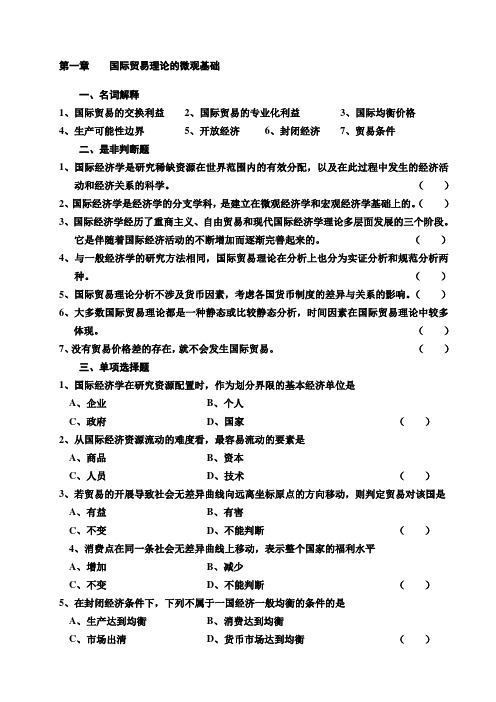
第一章国际贸易理论的微观基础一、名词解释1、国际贸易的交换利益2、国际贸易的专业化利益3、国际均衡价格4、生产可能性边界5、开放经济6、封闭经济7、贸易条件二、是非判断题1、国际经济学是研究稀缺资源在世界范围内的有效分配,以及在此过程中发生的经济活动和经济关系的科学。
()2、国际经济学是经济学的分支学科,是建立在微观经济学和宏观经济学基础上的。
()3、国际经济学经历了重商主义、自由贸易和现代国际经济学理论多层面发展的三个阶段。
它是伴随着国际经济活动的不断增加而逐渐完善起来的。
()4、与一般经济学的研究方法相同,国际贸易理论在分析上也分为实证分析和规范分析两种。
()5、国际贸易理论分析不涉及货币因素,考虑各国货币制度的差异与关系的影响。
()6、大多数国际贸易理论都是一种静态或比较静态分析,时间因素在国际贸易理论中较多体现。
()7、没有贸易价格差的存在,就不会发生国际贸易。
()三、单项选择题1、国际经济学在研究资源配置时,作为划分界限的基本经济单位是A、企业B、个人C、政府D、国家()2、从国际经济资源流动的难度看,最容易流动的要素是A、商品B、资本C、人员D、技术()3、若贸易的开展导致社会无差异曲线向远离坐标原点的方向移动,则判定贸易对该国是A、有益B、有害C、不变D、不能判断()4、消费点在同一条社会无差异曲线上移动,表示整个国家的福利水平A、增加B、减少C、不变D、不能判断()5、在封闭经济条件下,下列不属于一国经济一般均衡的条件的是A、生产达到均衡B、消费达到均衡6、国际贸易建立的基础是A、绝对价格B、相对价格C、不变价格D、以上三种都不是()7、在封闭经济条件下,A国X商品的相对价格低于B国X商品的相对价格,我们称A国在X商品上具有A、绝对优势B、比较优势C、没有优势D、以上三种都不是()8、一国从国际贸易中所获利益的多寡取决于A、市场占有率B、技术优势C、竞争优势D、贸易条件()四、简述题:1、试用图形分析国际贸易的交换利益和专业化利益。
同等学力研究生考试:国际经济学题库及答案
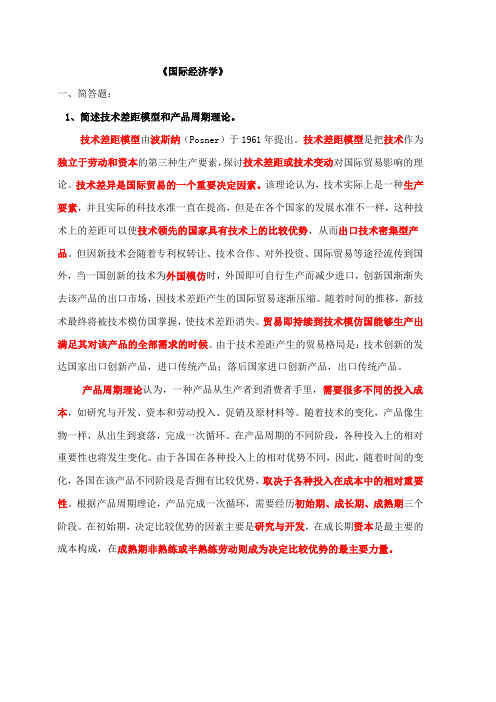
《国际经济学》一、简答题:1、简述技术差距模型和产品周期理论。
技术差距模型由波斯纳(Posner)于1961年提出。
技术差距模型是把技术作为独立于劳动和资本的第三种生产要素,探讨技术差距或技术变动对国际贸易影响的理论。
技术差异是国际贸易的一个重要决定因素。
该理论认为,技术实际上是一种生产要素,并且实际的科技水准一直在提高,但是在各个国家的发展水准不一样,这种技术上的差距可以使技术领先的国家具有技术上的比较优势,从而出口技术密集型产品。
但因新技术会随着专利权转让、技术合作、对外投资、国际贸易等途径流传到国外,当一国创新的技术为外国模仿时,外国即可自行生产而减少进口,创新国渐渐失去该产品的出口市场,因技术差距产生的国际贸易逐渐压缩。
随着时间的推移,新技术最终将被技术模仿国掌握,使技术差距消失。
贸易即持续到技术模仿国能够生产出满足其对该产品的全部需求的时候。
由于技术差距产生的贸易格局是:技术创新的发达国家出口创新产品,进口传统产品;落后国家进口创新产品,出口传统产品。
产品周期理论认为,一种产品从生产者到消费者手里,需要很多不同的投入成本,如研究与开发、资本和劳动投入、促销及原材料等。
随着技术的变化,产品像生物一样,从出生到衰落,完成一次循环。
在产品周期的不同阶段,各种投入上的相对重要性也将发生变化。
由于各国在各种投入上的相对优势不同,因此,随着时间的变化,各国在该产品不同阶段是否拥有比较优势,取决于各种投入在成本中的相对重要性。
根据产品周期理论,产品完成一次循环,需要经历初始期、成长期、成熟期三个阶段。
在初始期,决定比较优势的因素主要是研究与开发,在成长期资本是最主要的成本构成,在成熟期非熟练或半熟练劳动则成为决定比较优势的最主要力量。
2、简要论述重叠需求论的假设条件和主要观点。
重叠需求理论是由瑞典经济学家林德提出,其理论核心是:两国之间贸易关系的密切程度是由两国的需求结构与收入水平决定的。
重叠需求理论有两个假设条件: 1、消费者行为假设:假设在一国之内,需求受消费者的收入水平决定。
国际经济学试题及答案(题库)
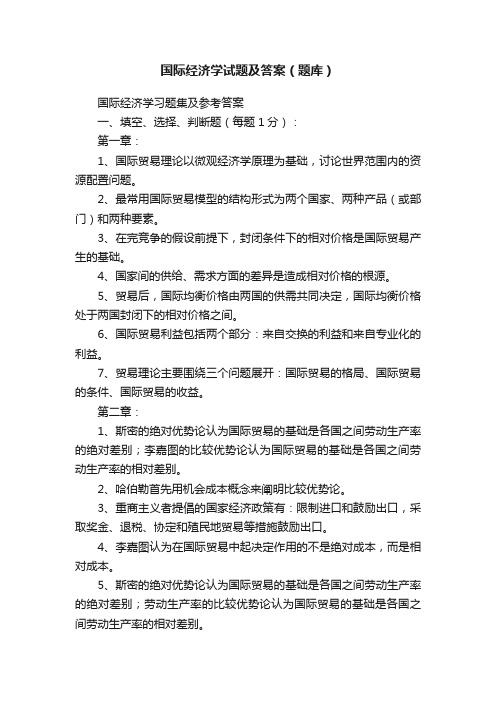
国际经济学试题及答案(题库)国际经济学习题集及参考答案一、填空、选择、判断题(每题1分):第一章:1、国际贸易理论以微观经济学原理为基础,讨论世界范围内的资源配置问题。
2、最常用国际贸易模型的结构形式为两个国家、两种产品(或部门)和两种要素。
3、在完竞争的假设前提下,封闭条件下的相对价格是国际贸易产生的基础。
4、国家间的供给、需求方面的差异是造成相对价格的根源。
5、贸易后,国际均衡价格由两国的供需共同决定,国际均衡价格处于两国封闭下的相对价格之间。
6、国际贸易利益包括两个部分:来自交换的利益和来自专业化的利益。
7、贸易理论主要围绕三个问题展开:国际贸易的格局、国际贸易的条件、国际贸易的收益。
第二章:1、斯密的绝对优势论认为国际贸易的基础是各国之间劳动生产率的绝对差别;李嘉图的比较优势论认为国际贸易的基础是各国之间劳动生产率的相对差别。
2、哈伯勒首先用机会成本概念来阐明比较优势论。
3、重商主义者提倡的国家经济政策有:限制进口和鼓励出口,采取奖金、退税、协定和殖民地贸易等措施鼓励出口。
4、李嘉图认为在国际贸易中起决定作用的不是绝对成本,而是相对成本。
5、斯密的绝对优势论认为国际贸易的基础是各国之间劳动生产率的绝对差别;劳动生产率的比较优势论认为国际贸易的基础是各国之间劳动生产率的相对差别。
6、在李嘉图模型中,生产可能性边界线方程是一个线性方程式,表示A、B两国的PPF曲线是一条直线段。
7、重商主义者提倡的国家经济政策有:限制进口和鼓励出口,采取奖金、退税、协定和殖民地贸易等措施鼓励出口。
8、李嘉图认为在国际贸易中起决定作用的不是绝对成本,而是相对成本。
9、机会成本概念表明:彼种选择的机会成本就构成此种选择的机会成本。
选择题:1、首先用机会成本理论来解释比较优势原理的学者是: C、A、李嘉图B、罗布津斯基C、哈伯勒D、穆勒第三章:1、要素禀赋理论最初是由赫克歇尔和俄林提出的,后经萨缪尔森等人加工不断完善。
《国际经济学》复习试卷5份和试题库(含答案)
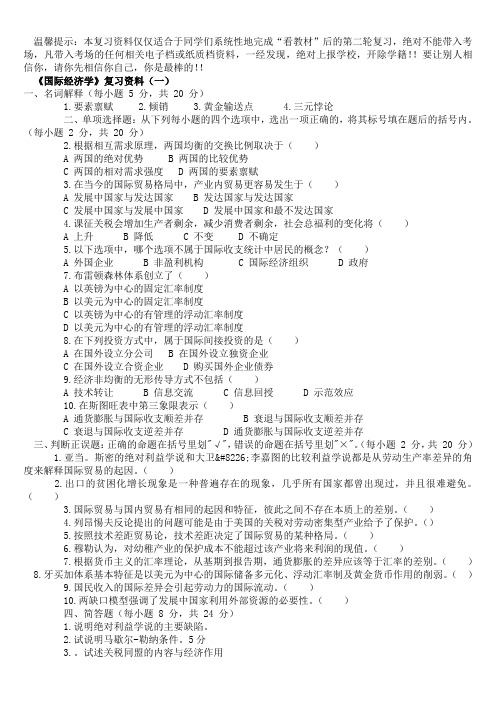
温馨提示:本复习资料仅仅适合于同学们系统性地完成“看教材”后的第二轮复习,绝对不能带入考场,凡带入考场的任何相关电子档或纸质档资料,一经发现,绝对上报学校,开除学籍!!要让别人相信你,请你先相信你自己,你是最棒的!!《国际经济学》复习资料(一)一、名词解释(每小题 5 分,共 20 分)1.要素禀赋2.倾销3.黄金输送点4.三元悖论二、单项选择题:从下列每小题的四个选项中,选出一项正确的,将其标号填在题后的括号内。
(每小题 2 分,共 20 分)2.根据相互需求原理,两国均衡的交换比例取决于()A 两国的绝对优势B 两国的比较优势C 两国的相对需求强度D 两国的要素禀赋3.在当今的国际贸易格局中,产业内贸易更容易发生于()A 发展中国家与发达国家B 发达国家与发达国家C 发展中国家与发展中国家D 发展中国家和最不发达国家4.课征关税会增加生产者剩余,减少消费者剩余,社会总福利的变化将()A 上升B 降低C 不变D 不确定5.以下选项中,哪个选项不属于国际收支统计中居民的概念?()A 外国企业B 非盈利机构C 国际经济组织D 政府7.布雷顿森林体系创立了()A 以英镑为中心的固定汇率制度B 以美元为中心的固定汇率制度C 以英镑为中心的有管理的浮动汇率制度D 以美元为中心的有管理的浮动汇率制度8.在下列投资方式中,属于国际间接投资的是()A 在国外设立分公司B 在国外设立独资企业C 在国外设立合资企业D 购买国外企业债券9.经济非均衡的无形传导方式不包括()A 技术转让B 信息交流C 信息回授D 示范效应10.在斯图旺表中第三象限表示()A 通货膨胀与国际收支顺差并存B 衰退与国际收支顺差并存C 衰退与国际收支逆差并存D 通货膨胀与国际收支逆差并存三、判断正误题:正确的命题在括号里划"√",错误的命题在括号里划"×"。
(每小题 2 分,共 20 分)1.亚当。
国际经济学试题05经济学类A卷答案
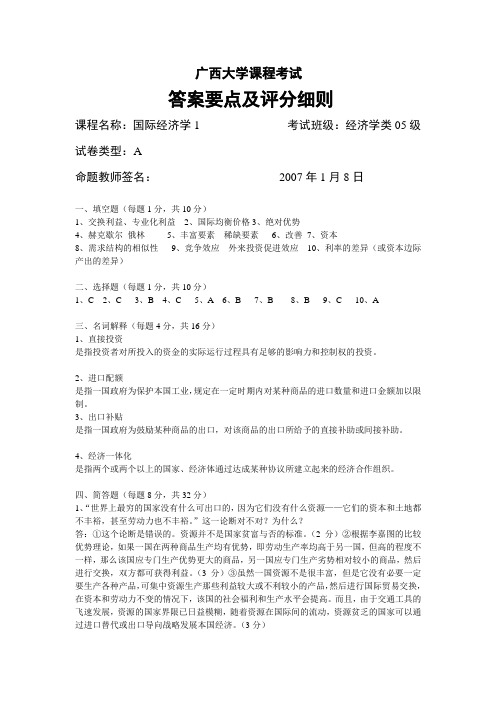
广西大学课程考试答案要点及评分细则课程名称:国际经济学1 考试班级:经济学类05级试卷类型:A命题教师签名:2007年1月8日一、填空题(每题1分,共10分)1、交换利益、专业化利益2、国际均衡价格3、绝对优势4、赫克歇尔俄林5、丰富要素稀缺要素6、改善7、资本8、需求结构的相似性9、竞争效应外来投资促进效应10、利率的差异(或资本边际产出的差异)二、选择题(每题1分,共10分)1、C2、C3、B4、C5、A6、B7、B8、B9、C 10、A三、名词解释(每题4分,共16分)1、直接投资是指投资者对所投入的资金的实际运行过程具有足够的影响力和控制权的投资。
2、进口配额是指一国政府为保护本国工业,规定在一定时期内对某种商品的进口数量和进口金额加以限制。
3、出口补贴是指一国政府为鼓励某种商品的出口,对该商品的出口所给予的直接补助或间接补助。
4、经济一体化是指两个或两个以上的国家、经济体通过达成某种协议所建立起来的经济合作组织。
四、简答题(每题8分,共32分)1、“世界上最穷的国家没有什么可出口的,因为它们没有什么资源——它们的资本和土地都不丰裕,甚至劳动力也不丰裕。
”这一论断对不对?为什么?答:①这个论断是错误的。
资源并不是国家贫富与否的标准。
(2分)②根据李嘉图的比较优势理论,如果一国在两种商品生产均有优势,即劳动生产率均高于另一国,但高的程度不一样,那么该国应专门生产优势更大的商品,另一国应专门生产劣势相对较小的商品,然后进行交换,双方都可获得利益。
(3分)③虽然一国资源不是很丰富,但是它没有必要一定要生产各种产品,可集中资源生产那些利益较大或不利较小的产品,然后进行国际贸易交换,在资本和劳动力不变的情况下,该国的社会福利和生产水平会提高。
而且,由于交通工具的飞速发展,资源的国家界限已日益模糊,随着资源在国际间的流动,资源贫乏的国家可以通过进口替代或出口导向战略发展本国经济。
(3分)2、试比较各种经济一体化形式之间的差异。
- 1、下载文档前请自行甄别文档内容的完整性,平台不提供额外的编辑、内容补充、找答案等附加服务。
- 2、"仅部分预览"的文档,不可在线预览部分如存在完整性等问题,可反馈申请退款(可完整预览的文档不适用该条件!)。
- 3、如文档侵犯您的权益,请联系客服反馈,我们会尽快为您处理(人工客服工作时间:9:00-18:30)。
同等学力培训:/kcnet1840/
国际经济学是同等学力热门专业经济综合中的重要课程,同等学力经济综合的考生需要对这门课程的知识点熟练掌握。
国际经济学,以经济学的一般理论为基础研究对象有国际贸易理论与政策、国际收支理论、汇率理论、要素的国际流动、国际投资理论、开放的宏观经济均衡等。
在考生备考的阶段,下面提供了以下同等学力经济综合国际经济学第五章考点测试题。
名词解释1、企业治理结构
2、道德风险
3、刺激一致性约束
4、参与约束
5、代理成本
6、企业所有权
7、内部人控制
8、行政干预下的经营者控制
9、企业共同治理
10、相机治理机制
简述题1、什么是代理问题?简述委托代理关系下的激励约束机制的设计
2、什么是代理成本?如何降低代理成本
3、简述行政干预下的经营者控制型治理结构的特征及存在的主要问题
论述题1、从人力资本产权的特征阐述企业治理结构主体的多元性
2、阐述利益相关者合作逻辑的基本含义。
国有企业的治理结构创新如何体现“共同治理”的原则
3、阐述相机治理机制的基本含义以及基本程序。
